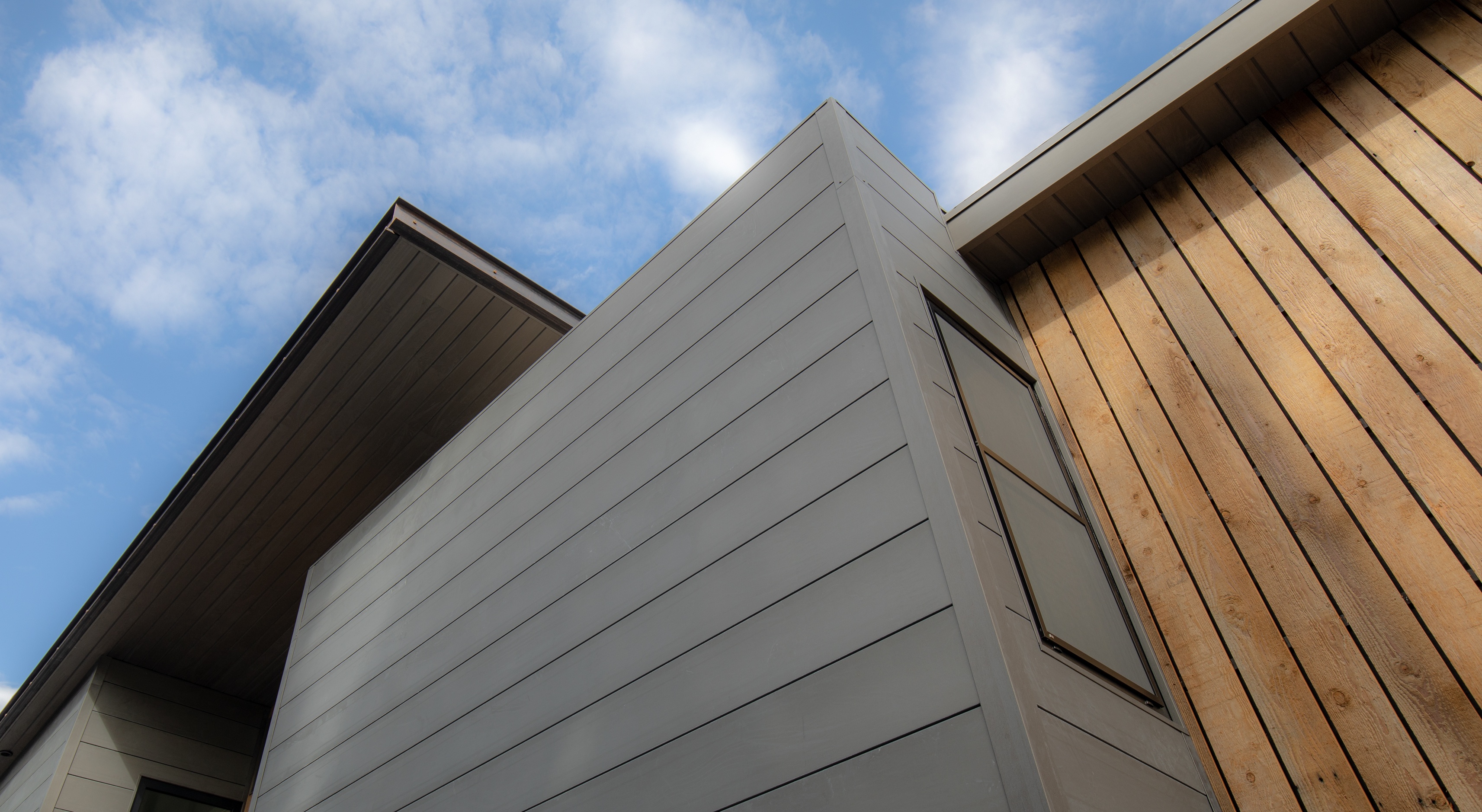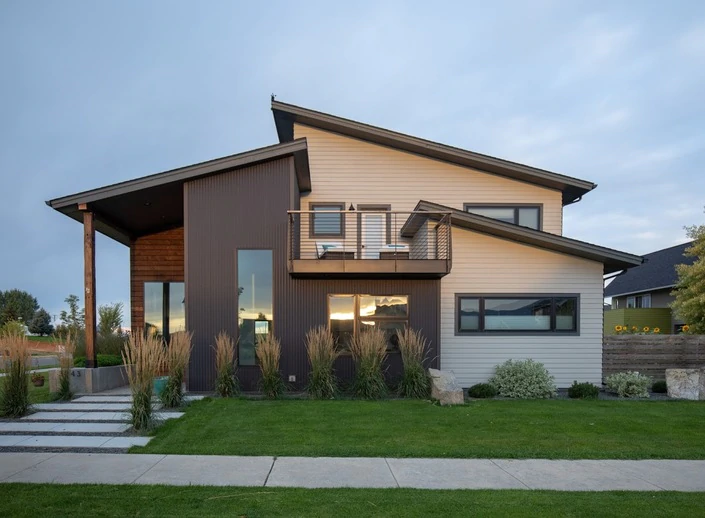Using Metal Siding on a Modern Home
How to Use Metal Siding on a Modern Home
A well-designed modern home looks clean and almost minimalistic in its finished form. This clean simplicity can sometimes hide the hours of intensive thought that went into each line, curve, and surface. Designers have to balance aesthetics, performance, longevity, and often most importantly, the surrounding landscape. New technologies have improved metal siding panel systems, allowing designers more flexibility in their designs, knowing that the performance and longevity of the product is up to their standards.
Challenges facing a Modern Facade
For a designer, one of the biggest challenges in a design is incorporating the natural aesthetics of materials seamlessly into the landscape. While the initial design may take the landscape into consideration, often as a project gets closer to completion performance and technical challenges alter available materials, and slowly take away from the visual appeal of the project.
In addition to aesthetics, performance during the lifespan of the home, and a need to build homes in an energy efficient and responsible manner add technical challenges to any contemporary build. Because of its ability to perform in all of these areas, metal siding is quickly becoming a popular option in contemporary residential designs.
The Aesthetics of Metal Siding
One reason metal panels are being used in new and creative manners in modern designs is their visual appeal. Using steel, aluminum, zinc or copper, panels can be molded and shaped into a range of finishes that when in the proper hands, can direct sight lines, create unique shadows, and allow a designer to get creative without the normal restrictions of traditional residential siding.
Complimentary Finishes
While some contemporary designs exclusively use metal siding as their exterior façade, other use the natural cooler finish of steel to compliment other materials on the exterior of the building. Combining natural steel colors with products like concrete or wood highlights the textures of each material in a minimal and complimentary manner.
Types of Metal Panels being used in Contemporary Homes
While metal panels offer an nearly unlimited range of panel profiles, in current designs a few styles are standing out from the pack. Panels traditionally used for commercial projects like box rib panels, all purpose panels (like Tuff Rib or Delta Rib), and industrial looks like Platte River are being used in creative manners, most new designs fall within a few key panel types.
Standing Seam Panels
Standing seam, or standing rib panels, have traditionally been used in roofing applications due to their high performance and clean lines. Standing seam panels used concealed fasteners that hide the screws beneath the panel, making them especially appealing for the detail-orientated designer. What began as a roofing panel has recently morphed into a vertical siding panel because of the same features that drew attention to it on the roof. The clean lines and hidden fasteners make it a perfect siding panel, and give the added bonus of allowing the lines from the roof to continue through the facade in a waterfall effect.
Shiplap Panels
Another popular option for residential siding is the metal shiplap panel (shown in photo above). With more subtle lines than the standing seams, shiplap combines the appeal of a traditionally wooden siding, with the performance and aesthetics of a modern metal siding panel system. Of the three options discussed in this article, shiplap is the most subtle in appearance and often used in areas where detail will be most noticed like entryways and patio accent walls.
Batten Panels
Among the most popular panels at Bridger Steel, the Ultra Batten wall panel is a big favorite with designers looking for a bold statement in their facade. While the shiplap and standing seam provide a subtle look, the Ultra and Snap Batten panels are chosen for their dramatic lines. Emulating a traditional board and batten look, the use of this panel in a facade can influence sight lines like no other, making it very appealing to designers and homeowners alike.
Corrugated Panels
While traditionally thought of as an agricultural or commercial panel, corrugated metal siding has had an increased interest due to its ability to cast shadows uniquely among metal panel systems. When combined with darker finishes, the corrugated panel offers an extremely durable panel that becomes very refined for an external fastener panel system. Ran both vertically and horizontally, this panel is often seen in contemporary homes as a complimentary finish to brighter wood materials.
Performance Considerations for Metal Siding
Metal panels have a well-known history of being durable, long-lasting products with some examples lasting centuries (copper) and most lasting well past 50 years. While metals like aluminum, zinc and copper have naturally long-lasting lifespans, steel panel systems get their longevity through the protective coatings that are applied to the steel itself.
Longevity of Steel Panels
Inside each painted steel panel are a number of layers that, depending on the combination, can last decades. Without these protective coatings, steel would still have a long lifespan, but rusting would inevitably set in and lower the overall performance of the product. To combat this, mills across the country started using alloy coatings to protect the inner layer of steel. These coatings are where we get galvanized and galvalume steel, each using its own mixture of zinc, aluminum, and other metals to provide a protective barrier for the base steel inside.

In addition to the coating, painted steel has a number of additional layers of paint. These layers can be adjusted based on the customers requests providing varying levels of longevity.
Because of the various adjustable layers of a metal panel system, warranties vary widely throughout the industry, from 10 to 50 years in length. These warranties almost always are paint-based warranties, covering the chalk and fade of the color itself. It is important to note that chalk and fade, even after 45-50 years still mean the inner layers of steel are protected for many decades to come. Only when the inner bare steel is exposed does the integrity of the panel begin to weaken.
Durability of Steel Siding
Due to its location on a building, steel facades have less impact from weather conditions than their roofing counterparts. While each steel panel is designed to hold up directly against conditions like hail or wind, as a siding panel these conditions are typically lessened in impact.
Which Gauge Should I Use For Metal Siding?
A general rule to follow would be the thicker the metal, the better the long-term performance. However, installing 14 gauge steel (or 063 aluminum) as a metal siding panel would be considered overkill in the vast majority of residential projects. Using steel as an example, 24 gauge would offer you the best protection when compared to your needs, while 26, 28, and 29 gauge are also commonly used products in siding applications.
How much does Metal Siding cost?
Metal siding can range widely in price depending on a number of factors. These can include the following:
Type of Base Material: Steel, Aluminum, Zinc or Copper
Thickness of Material: Base, Substrate, etc.
Quality of Paint Systems: SMP, PVDF, etc.
Panel Waste: Extra material used in making of panel
Clip System: Type of fastening of panel
Most residential designs are looking at steel or aluminum options, while copper and zinc are usually used more in commercial roofing or accents away from the ability to touch them. While steel is a commodity and pricing may vary dependent on a number of factors (listed above), the average price for a metal siding panel should range from $1-4 sqft. in a residential design.
How to Choose the right Metal Siding
Most manufacturers can help you choose the right panel for your design. If you are using a designer or architect, they often will have a few suggestions to choose from after working with the manufacturer themselves. For any build there are going to be a range of options that fit the performance requirements, and often it will come down to aesthetics and pricing.
Bonus Tip: Remember that the process for creating cut-to-length panel systems requires detailed information about your project. The manufacturer can often help develop a take-off, but will need dimensions to use (usually in the form of blueprints or drawings). It is important to have your installer confirm the measurements before signing off on the final order for production. Depending on the time of the year and the panel system you are using, it is a good idea to plan on placing your order 3-5 weeks ahead of when you expect the material to arrive at the job-site (check with your manufacturer for current lead times). This will ensure that the raw materials are available for the manufacturer, and they are able to fit you into the production schedule in time for your build.
Metal siding products shown in this artcle
This modern home was designed using 24 gauge steel in a bonderized steel finish. The panels shown are shiplap metal siding, and 7/8" corrugated metal siding. For additional specifications or details please contact a Bridger Steel representative. In consideration of the privacy of our customers, no personal information or location details will be provided under any circumstances.
Recent Posts
-
Do it Yourself Safety Tips
Tips for DIY InstallersNo matter the project, whether you just purchased a home, you’re working to …Jun 3rd 2020 -
Guide to Ordering Samples Online
How to Order Samples at Bridger SteelPurchasing metal samples is a great way to ensure your finishe …May 11th 2020 -
Four Gift Ideas for Mother’s Day
Gift Ideas for Mother's Day By Bridger SteelDuring these unprecedented times, one thing for sure is …Apr 21st 2020

